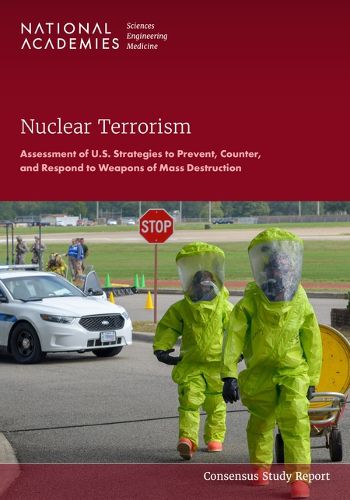Readings Newsletter
Become a Readings Member to make your shopping experience even easier.
Sign in or sign up for free!
You’re not far away from qualifying for FREE standard shipping within Australia
You’ve qualified for FREE standard shipping within Australia
The cart is loading…






For nearly eight decades, the world has been navigating the dangers of the nuclear age. Despite Cold War tensions and the rise of global terrorism, nuclear weapons have not been used in conflict since Hiroshima and Nagasaki in 1945. Efforts such as strategic deterrence, arms control and non-proliferation agreements, and the U.S.-led global counterterrorism have helped to keep nuclear incidents at bay. However, the nation's success to date in countering nuclear terrorism does not come with a guarantee, success often carries the risk that other challenges will siphon away attention and resources and can lead to the perception that the threat no longer exists.
This report found that U.S. efforts to counter nuclear or radiological terrorism are not keeping pace with the evolving threat landscape. The U.S. government should maintain a strategic focus and effort on combatting terrorism across the national security community in coordination with international partners, State, Local, Tribal and Territorial authorities, the National Laboratories, universities and colleges, and civil society. Developing and sustaining adequate nuclear incident response and recovery capabilities at the local and state levels will likely require significant new investments in resources and empowerment of local response from Federal Emergency Management Agency (FEMA), working with the Centers for Disease Control and Prevention, Environmental Protection Agency, Department of Energy, and National Institutes of Health.
Table of Contents
Front Matter Executive Summary Summary 1 Background and Study Task 2 Nuclear Terrorism Threats 3 New Dynamics in Nuclear Terrorism Pose New Risks 4 Geopolitical and Other Changes Eroding Long-Standing Nuclear Security Norms and Practices 5 The Evolving Civil Nuclear Energy Sector: Adapting Approaches and New Opportunities 6 The Risks Associated with Highly Enriched Uranium and Plutonium 7 Managing the Risks and Benefits of Radioactive Sources 8 Detection and Interdiction Efforts within and Outside the Global Supply System 9 Response to and Recovery from Nuclear Incidents Appendix A: Presentations at the Committee's Public Information-Gathering Sessions Appendix B: Five Eras of Nuclear Terrorism Appendix C: Biographies of Committee, Consultant, and Study Director
$9.00 standard shipping within Australia
FREE standard shipping within Australia for orders over $100.00
Express & International shipping calculated at checkout
For nearly eight decades, the world has been navigating the dangers of the nuclear age. Despite Cold War tensions and the rise of global terrorism, nuclear weapons have not been used in conflict since Hiroshima and Nagasaki in 1945. Efforts such as strategic deterrence, arms control and non-proliferation agreements, and the U.S.-led global counterterrorism have helped to keep nuclear incidents at bay. However, the nation's success to date in countering nuclear terrorism does not come with a guarantee, success often carries the risk that other challenges will siphon away attention and resources and can lead to the perception that the threat no longer exists.
This report found that U.S. efforts to counter nuclear or radiological terrorism are not keeping pace with the evolving threat landscape. The U.S. government should maintain a strategic focus and effort on combatting terrorism across the national security community in coordination with international partners, State, Local, Tribal and Territorial authorities, the National Laboratories, universities and colleges, and civil society. Developing and sustaining adequate nuclear incident response and recovery capabilities at the local and state levels will likely require significant new investments in resources and empowerment of local response from Federal Emergency Management Agency (FEMA), working with the Centers for Disease Control and Prevention, Environmental Protection Agency, Department of Energy, and National Institutes of Health.
Table of Contents
Front Matter Executive Summary Summary 1 Background and Study Task 2 Nuclear Terrorism Threats 3 New Dynamics in Nuclear Terrorism Pose New Risks 4 Geopolitical and Other Changes Eroding Long-Standing Nuclear Security Norms and Practices 5 The Evolving Civil Nuclear Energy Sector: Adapting Approaches and New Opportunities 6 The Risks Associated with Highly Enriched Uranium and Plutonium 7 Managing the Risks and Benefits of Radioactive Sources 8 Detection and Interdiction Efforts within and Outside the Global Supply System 9 Response to and Recovery from Nuclear Incidents Appendix A: Presentations at the Committee's Public Information-Gathering Sessions Appendix B: Five Eras of Nuclear Terrorism Appendix C: Biographies of Committee, Consultant, and Study Director